Two weeks until California slashes rooftop solar incentives
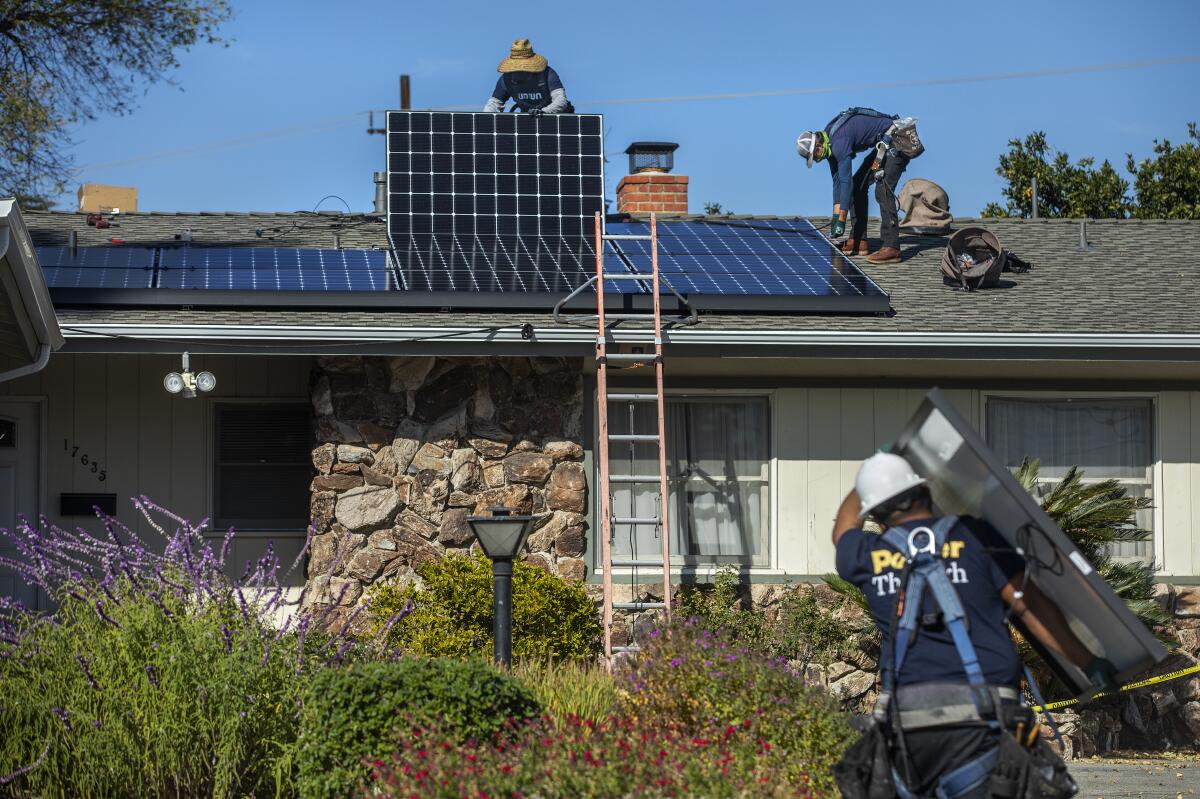
This story originally published in Boiling Point, a weekly newsletter about climate change and the environment. Sign up here to get it in your inbox.
It’s been nearly a decade since California lawmakers ordered the state’s Public Utilities Commission to revamp a rooftop solar incentive program called net metering. In two weeks, we’ll finally begin to see the consequences of that decision.
After 11:59 p.m. on Friday, April 14, most Californians who want to put panels on their roofs will no longer have access to the same incentives that have helped more than 1.6 million homes and businesses go solar. Instead, they’ll be faced with a far less generous incentive program known as net billing, which will result in lower savings on monthly electricity bills.
I wrote last year about why state officials decided to slash solar payments. It boils down to the idea that monopoly utilities such as Southern California Edison don’t collect as much money from homes with solar, forcing them to charge more to lower-income customers who can’t afford solar. Rooftop installers and many clean energy activists reject that claim as wildly exaggerated.
The rooftop solar industry lost the argument. Now it’s time to study what happens next.
EnergySage, a company that helps consumers compare rooftop solar bids from vetted contractors, released some useful data this month after surveying 35 installers. Nearly three-quarters said the new incentive program would significantly harm the California solar industry, with 90% expecting some amount of harm. Just one survey respondent said it would help the industry.
More optimistically, solar companies told EnergySage they expect the number of customers who install a battery alongside their rooftop panels to rise from 19% to 71%. Two-thirds of respondents said they plan to invest more in energy-storage sales.
That should be welcome news to Gov. Gavin Newsom’s appointees on the Public Utilities Commission, who said one of their goals in lowering incentive payments for standalone solar systems was to encourage homes and businesses to add batteries.

But overall, installers painted a bleak picture of where the market is headed. One in five solar companies said they plan to slow hiring. Nearly three in five said they’re less confident in the industry’s future in the state than they were a year ago.
EnergySage CEO Vikram Aggarwal told me he expects solar installations to fall by half.
“This is bad. In America, with capitalism, we’re very much used to growing year after year,” he said.
The reduced solar payments won’t affect homes that already have rooftop systems in place, or customers of government-run electric utilities such as the Los Angeles Department of Water and Power. But the majority of Californians are served by the big investor-owned utilities regulated by the utilities commission: Edison, Pacific Gas & Electric and San Diego Gas & Electric.
If there’s any saving grace for the solar industry, it’s that business has been gangbusters the last few months.
EnergySage says the number of Californians buying solar through its digital marketplace has increased by more than 500% this quarter, as homes and businesses rush to qualify for the stronger incentive program before it goes away. My own reporting bears that out. I talked this week with leaders of several installers across the state, all of whom told me their employees are scrambling to keep up with unprecedented demand and get photovoltaic panels on roofs before the April 14 deadline.
“Our people are working around the clock,” said Mark Figearo, chief executive of Green Convergence in Santa Clarita.
The surge in installations has created challenges — including for the monopoly electric utilities.
Before a home or business can power up its solar panels and connect to the grid, it must file an “interconnection request” with its electric utility. For many Californians, getting those requests approved has been slow as utilities grapple with the large increase in applications. Edison has told customers it may take up to 20 business days to review their requests.
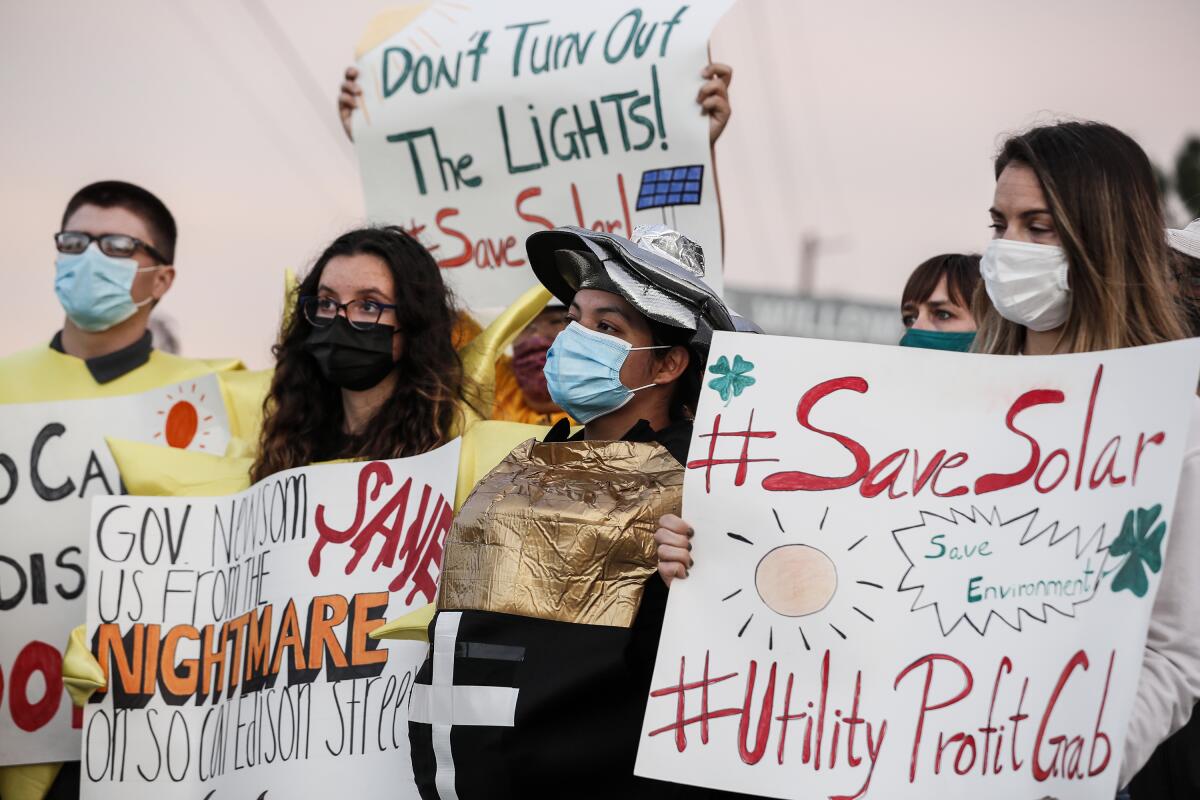
The delays have left installers worried about what will happen in cases where utilities reject a request as incomplete or containing errors. Homes and businesses have until April 14 to submit their paperwork — but what if Edison or PG&E issues a rejection on April 15? Or on April 12, leaving too little time for the solar installer to correct and resubmit the request? Will families who signed solar contracts under the expectation of net metering find themselves stuck with the weaker incentives?
Vincent Battaglia, chief executive of Renova Energy in the Coachella Valley, told me he’s set a deadline of March 31 to submit requests to Edison, out of fear the utility will scour the paperwork for small, insignificant mistakes to try to limit the number of people who can qualify for net metering and secure years of higher payments for the solar electricity they produce.
“They’re kind of making the rules up as they go, which leads me to be suspicious,” Battaglia said.
Brad Heavner, policy director at the California Solar & Storage Assn., an industry trade group, told me installers are “on pins and needles right now” about how Edison and the other investor-owned utilities will deal with last-minute paperwork errors. He said the utility companies have ensured the solar industry they’ll allow minor mistakes to be fixed after the April 14 deadline, but they haven’t offered enough guidance on what constitutes a major mistake versus a minor one.
“We’re very nervous. It’s all up to them,” Heavner said. “They could say anything is a major deficiency.”
Asked about those concerns, Edison spokesperson Ron Gales emailed me a detailed list of “major” and “minor” deficiencies. He also told me the processing delays have been caused by the incredible volume of solar applications — 16,000 in January, 24,000 in February and an expected 55,000 in March, compared with an average of 4,000 a month in recent years.
Although Edison staffed up in anticipation of a last-minute surge, “no one predicted this level of volume,” he wrote.
Solar installers in parts of northern and central California served by PG&E described an additional problem: The utility’s website for submitting interconnection requests has been periodically down for maintenance, and occasionally glitching out.
“Recently, we’ve been able to get through the whole application process until we try to pay with a credit card, and the credit card processing has been crashing,” said Barry Cinnamon, chief executive of Bay Area solar installer Cinnamon Energy Systems.
“It’s a hostile bureaucracy. They don’t have any incentive to make the website better,” he added.
When I ran that complaint by PG&E spokesperson Lynsey Paulo, she blamed a “significant increase in traffic,” about three times the typical monthly average to the solar applications page. She said the site “has experienced temporary performance issues just over the last week,” and that “those issues have been quickly resolved.” If there are more problems closer to the April 14 deadline, she said, the company would be lenient with customers submitting last-minute solar connection requests.
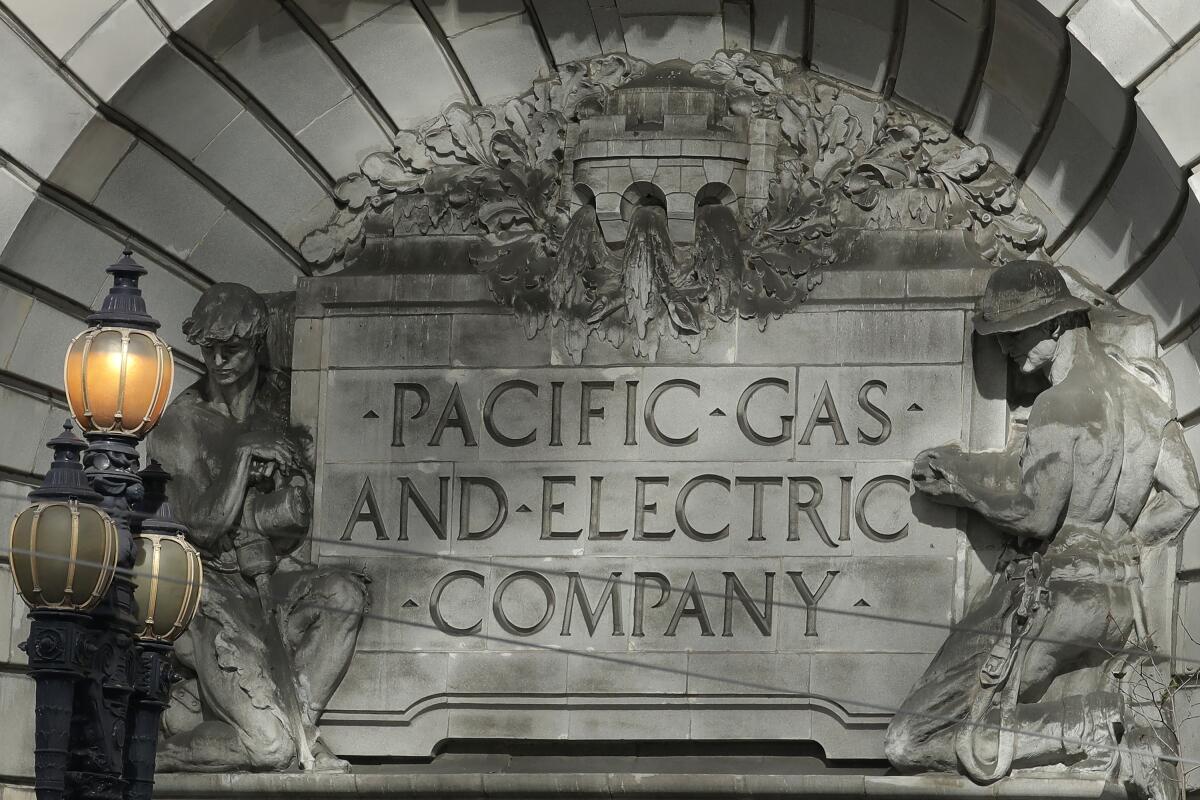
Also important: Just because net metering is going away doesn’t mean there’s no financial case for solar anymore.
Aggarwal, the EnergySage CEO, said Texas and Florida have similar solar “payback periods” — the number of years it takes customers to make back their upfront investment — as California is expected to have under the new incentive program. Those states haven’t installed nearly as much solar as this one, but they’re still the country’s second- and third-largest markets.
“Utilities are asking for further rate increases, and will continue to ask for further rate increases,” Aggarwal said. “Not everybody will be able to afford [solar]. But as electricity prices go up, solar again will become more affordable.”
Some clean energy advocates are holding out hope that they can keep current incentive levels in place.
In January, three advocacy groups — the Center for Biological Diversity, Environmental Working Group and Protect Our Communities Foundation — filed a formal appeal asking the Public Utilities Commission to reconsider its December decision.
The groups argued that commission officials hadn’t complied with the 2013 law requiring them to reevaluate net metering, in part because they’d failed to take into account all the benefits of rooftop solar — such as protecting homes from blackouts and utility power shutoffs, slashing air pollution from fossil fueled power plants in low-income communities, reducing the need for expensive long-distance transmission lines and potentially limiting the environmental damage from large solar farms.
The Public Utilities Commission hasn’t yet responded to the appeal.
“We’re hopeful that they do the right thing, and we don’t have to take this to court,” said Roger Lin, an attorney at the Center for Biological Diversity.
This isn’t the only case where the utilities commission has disappointed rooftop solar advocates.
Just last month, commission staff proposed to dismiss an application from Houston-based installer Sunnova to build solar-plus-storage microgrids to power whole neighborhoods, without any involvement from the monopoly utilities. The arguments for and against Sunnova’s plan are complicated. The company says it can offer families a cheaper way to keep the lights on; critics worry its microgrids would raise utility bills for everyone else, or even backfire if the company can’t live up to its obligations.
“Our hope is that the commission recognizes that this is an opportunity for them, and that we don’t bureaucracy ourselves out of innovation and competition,” said Meghan Nutting, Sunnova’s executive vice president for government and regulatory affairs.
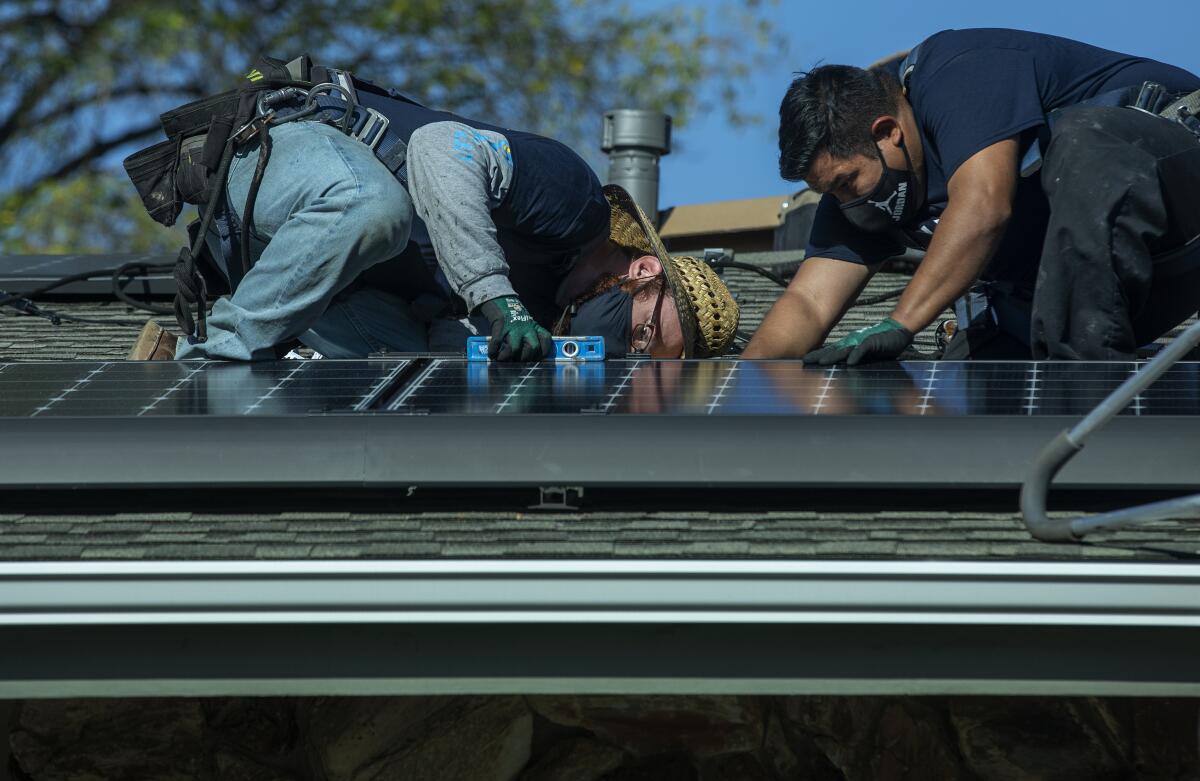
Whoever is right, this is another example of state officials grappling with the growing number of people and businesses looking for alternatives to traditional monopoly utilities — and at least so far, choosing to play it slow and cautious.
For Matt Baker, who leads the utilities commission’s ratepayer advocacy office, a totally decentralized power grid isn’t the solution to our climate change and cost problems. But neither is what he called the “one ring” approach of letting utilities do everything (a reference to “one ring to rule them all” from the “Lord of the Rings” trilogy, which my editor insists I need to explain).
Baker supported slashing rooftop solar incentives because he believes doing so will result in lower electricity bills for homes that don’t have solar. He also urged the commission to reject Sunnova’s microgrid application on similar grounds. But he’s convinced we need a lot more rooftop solar, and he sees a role for microgrids too. He thinks the key is to move slowly and carefully.
“It’s all going to be very expensive, unless we try to make sure that things are as cost-based as possible,” he said.
And here’s where we get to the crux of the challenge. California needs to move ridiculously fast to stop burning fossil fuels and limit the damage from climate change, as does the rest of the world. But what’s the right balance between big solar farms, small rooftop systems and other forms of clean energy? And how do we keep power costs from rising so fast that people won’t want to buy or lease electric cars, and replace their gas furnaces with electric heat pumps?
Part of California’s answer was to do away with net metering. Starting in two weeks, we’ll see the results.
On that note, here’s what else is happening around the West:
POLITICAL CLIMATE
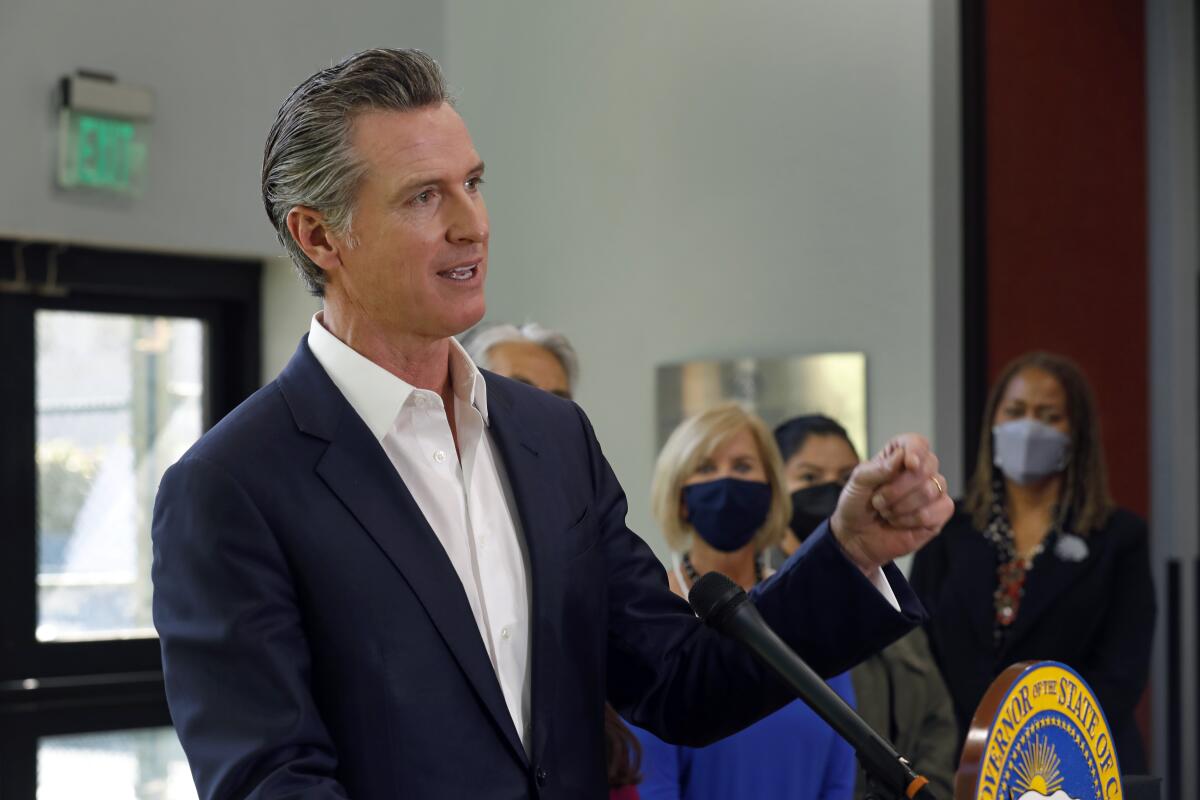
California lawmakers approved a bill backed by Gov. Gavin Newsom that will give state officials the authority to cap oil-industry profits, if they determine that refiners are ripping off drivers. Details here from The Times’ Taryn Luna, who writes that oil companies warn the law could backfire and lead to higher gas prices. Newsom didn’t get everything he wanted, but the bill’s passage was still a political win for the potential presidential contender, Luna and Laurel Rosenhall write. State Sen. Scott Wiener, meanwhile, is once again pushing a bill that would require large companies doing business in California to disclose their carbon pollution. His proposal fell one vote short of passage last year amid corporate opposition, my colleague Dorany Pineda reports. There are also two bills in Sacramento that would speed approval of new transmission lines, in hopes of making it easier to supply cities with energy from distant solar and wind farms. The Sacramento Bee’s Ari Plachta wrote about those bills.
The U.S. Forest Service is being sued over its use of fire retardant drops, which critics say pollute rivers and don’t actually do much to fight wildfires. The Forest Service strongly disagrees, arguing that retardant is a crucial firefighting tool that can help slow the spread of flames and give ground crews a fighting chance to contain them, my colleague Alex Wigglesworth reports. Paradise Mayor Greg Bolin — whose town was razed by the Camp fire — is on the federal agency’s side. “This is going to destroy towns and many communities in California, if they allow this to go through,” he said. “To maybe save a few fish, really?”
Long Beach will get $30 million under the federal infrastructure law to move back freeway lanes from elementary schools and expand a public park. Pasadena is getting some money too, with both cities working to address the legacy of an abandoned plan to expand the 710 Freeway, LAist’s Erin Stone writes. For background on the 710 battle, see this story by The Times’ Rachel Uranga on the environmental justice activists who defeated the expansion plan, which could have resulted in even worse air quality in low-income communities of color. The legacy of freeway construction continues to be a fraught issue nationally. Just last month, after criticism from Republicans, the Biden administration stopped advising states to spend federal infrastructure funds with climate change and environmental justice in mind, Aydali Campa and Kristoffer Tigue report for Inside Climate News.
ALL THE WATER, ALL AT ONCE
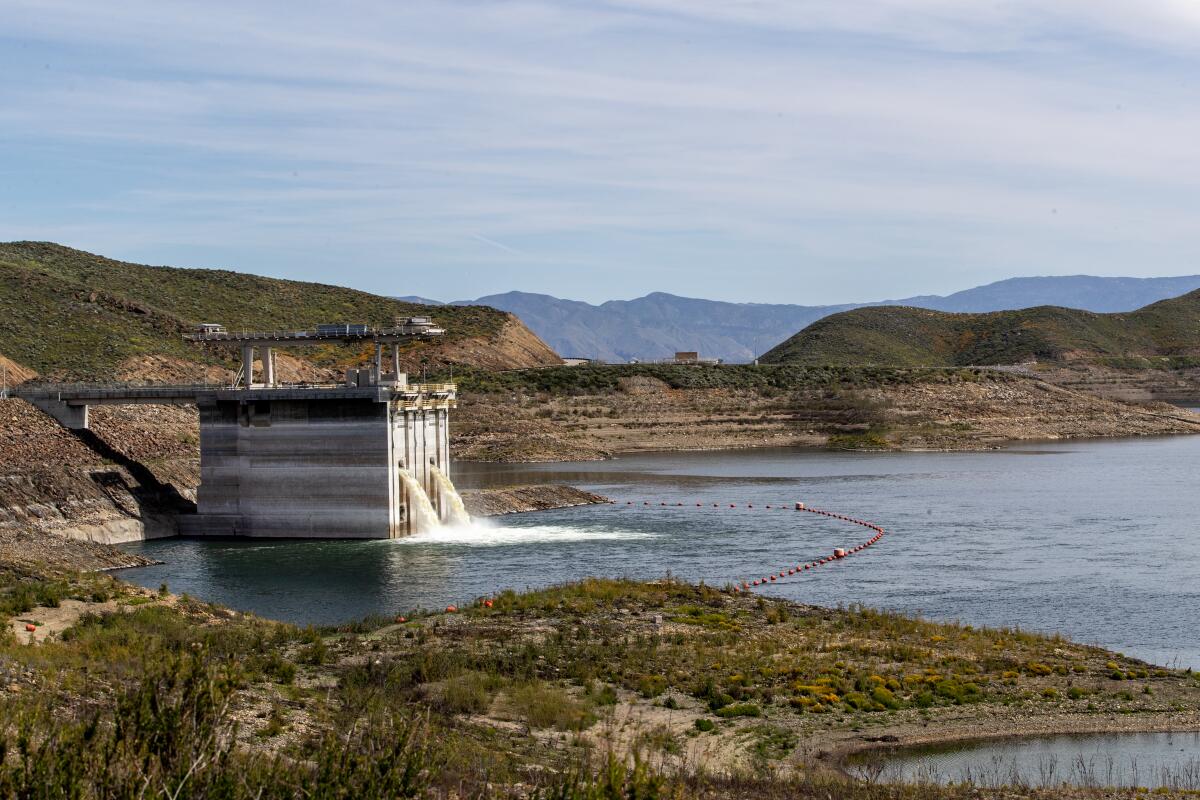
Southern California is refilling its largest reservoir — a good sign for water supplies following record storms. The Times’ Hayley Smith wrote about the dramatic turn of events at Diamond Valley Lake, and about Gov. Gavin Newsom’s decision to roll back drought restrictions such as limits on outdoor watering. The governor was motivated by extraordinary snowpack, including a record 286% of average in the southern Sierra Nevada, as my colleague Terry Castleman reports. But Newsom stopped short of declaring the drought over — to the annoyance of Times columnist George Skelton, who wrote, “When government doesn’t level with people and they know it, they become even more cynical and tune out officials trying to lead them.”
The largest freshwater lake west of the Mississippi River is back in full force, drowning towns and farmland. My colleagues Ian James and Susanne Rust have the harrowing tale of Tulare Lake’s return to California’s San Joaquin Valley. It’s a reminder that getting so much water all at once — an event made more likely by climate change — is not all good. Same with this gripping story by Louis Sahagún, about the L.A. Department of Water and Power’s frantic efforts to repair the Los Angeles Aqueduct after it was damaged by epic floods. Then there’s the continued heartbreak in the farmworker community of Parajo, where children can’t go back to school after terrible floods, as The Times’ Melissa Gomez reports. Newsom promised to request federal aid for the town, but it took him nearly two weeks. Why? Rust and Ruben Vives explored the reasons for the delay.
Should there be a United Nations-led negotiation process for protecting our planet’s shared water resources, like there is for our shared climate? That was one idea floated at the U.N.’s first global water conference in 46 years. Ian James wrote about the discussions, which were hugely relevant to California and the West. “Water is in deep trouble,” U.N. Secretary-General António Guterres said. “We are draining humanity’s lifeblood through vampiric overconsumption and unsustainable use, and evaporating it through global heating. We’ve broken the water cycle, destroyed ecosystems and contaminated groundwater.”
THE ENERGY TRANSITION
Electric vehicles are far more prevalent in parts of California that are at least 75% white and Asian, with wealthier, more educated residents. That’s according to a new analysis from CalMatters’ Nadia Lopez and Erica Yee, and although it’s not exactly surprising, it underscores the need for policies that do more to help lower-income Californians — including many people of color — make the switch to electric. I also learned a lot from this story by Jessica Kutz at The 19th, examining some of the reasons men are more likely to drive EVs than women — including the safety risk involved in spending a lot of time waiting at remote or out-of-the-way changing stations. We definitely need a lot more chargers in convenient locations; as E&E News’ David Ferris wrote in a recent piece about a Western road trip, “The electric road trip isn’t debugged, scaled up or ready for mass adoption.”
What’s more important to Americans: Protecting natural lands and wildlife, or quickly building out renewable energy projects to reduce climate pollution? In a new national poll commissioned by Heatmap, a whopping 79% chose conservation over clean energy, Robinson Meyer wrote. That’s a crucial dynamic to understand as badly needed solar farms and wind turbines face opposition from conservationists and nearby residents, a topic that — stop me if you’ve heard this one — I’ve been covering as part of our Repowering the West series. I explored a specific example in last week’s Boiling Point newsletter, which dealt with a renewable energy company threatening to sue the Biden administration over protections for an endangered toad.
Solar power towers are not yet dead — at least not according to the U.S. Department of Energy, which broke ground last month on a pilot project in New Mexico seeking to jump-start concentrating solar technology. Here’s the story from Emma Foehringer Merchant at Heatmap. If you’re familiar with concentrating solar, it may be because you’ve seen the giant towers just north of the 15 Freeway between Los Angeles and Las Vegas, which are so bright at the top it’s hard to look at them. That project, known as Ivanpah, has had all sorts of problems. So has the nation’s other major power-tower project, Crescent Dunes in Nevada. But supporters say the technology still holds great potential in its ability to store solar power for after dark.
AROUND THE WEST
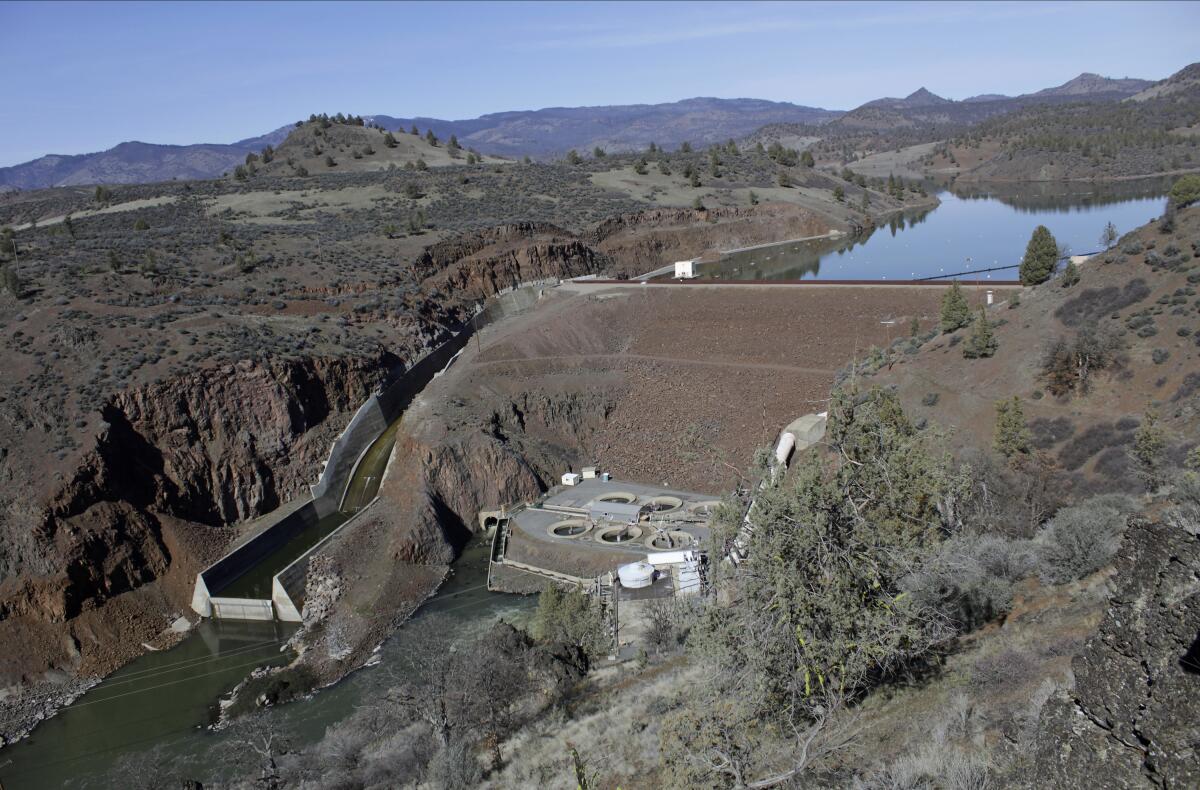
Work has begun on a long-awaited plan to tear down four dams on the Klamath River in Northern California and Oregon — the largest dam removal project in U.S. history. Here’s the latest from Jackson Guilfoil at the Eureka Times-Standard, who writes that the dams should be gone by the end of 2024. For more context, see this piece by my colleague Hayley Smith, who explained how the dam removal is “paving the way for hundreds of miles of native fish habitat along the California-Oregon border to flow freely for the first time in more than a century.” The project hasn’t resolved all water disputes in Klamath Basin, though. Just last week, the Yurok Tribe and the Pacific Coast Federation of Fishermen’s Associations sued the U.S. Bureau of Reclamation, arguing the agency has left illegally low amounts of water in the Klamath River, per Sage Alexander at the Times-Standard.
Representatives of the grass-roots group Apache Stronghold were in Pasadena last week, trying to persuade an appeals court to block an Arizona copper mine that they say would destroy Oak Flat, one of the Apache people’s most sacred sites. The Arizona Republic’s Debra Utacia Krol was at the hearing, and wrote about what the judges had to say. This is one of a growing number of conflicts involving mining proposals that could support the clean energy transition but face opposition due to their environmental and cultural impacts. We may be able to avoid at least some of those conflicts thanks to the federal infrastructure law. Writing for Grist, Maddie Stone explained that the 2021 law offered a sixfold funding increase for a U.S. Geological Survey program to map critical minerals across the country — possibly including low-conflict deposits we haven’t found yet.
Should the federal government ban permanent climbing anchors in wilderness areas without a permit, like they did in Joshua Tree National Park last year? I’m fascinated by the arguments for and against, as laid out in this story by the Colorado Sun’s Jason Blevins. Critics say the proposal could turn climbers — traditionally wilderness allies — into conservation foes.
ONE MORE THING
I haven’t paid much attention to Republican efforts to pass a sweeping pro-fossil fuel energy bill in the House of Representatives, because there’s essentially zero chance the legislation is approved by the Senate and reaches President Biden’s desk.
But another House Republican proposal caught my attention. This one is a resolution urging the Biden administration to halt approval of new offshore wind projects until more study can be conducted into their environmental impacts. The resolution’s backers cite a recent spate of whale deaths along the East Coast, which they blame on the offshore wind industry.
Here’s the thing: As Inside Climate News’ Kristoffer Tigue explains, there is currently no science whatsoever linking the whale die-off to wind energy. It would make little sense, since there are currently no offshore wind farms under construction. Scientists told Tigue that the best evidence so far points to ship collisions and entanglement in fishing gear as the most likely culprits.
So what’s going on here? It seems pretty straightforward that the half-dozen Republican politicians behind this resolution are looking for an excuse to block a renewable energy source they don’t like. It’s pretty brazen, especially considering their staunch support for offshore oil and gas drilling that experts say does far more damage to the environment and human health.
If you’re looking for something real to worry about in our coastal waters, my colleague Rosanna Xia wrote about startling new research finding that deposits of DDT along the ocean floor off the Southern California coast aren’t breaking down as expected and may be moving across the undersea food web. The story is Xia’s latest missive on the toxic chemical, following her eye-opening 2020 deep dive (puns intended).
We’ll be back in your inbox on Thursday. To view this newsletter in your Web browser, click here. And for more climate and environment news, follow @Sammy_Roth on Twitter.
Toward a more sustainable California
Get Boiling Point, our newsletter exploring climate change, energy and the environment, and become part of the conversation — and the solution.
You may occasionally receive promotional content from the Los Angeles Times.




